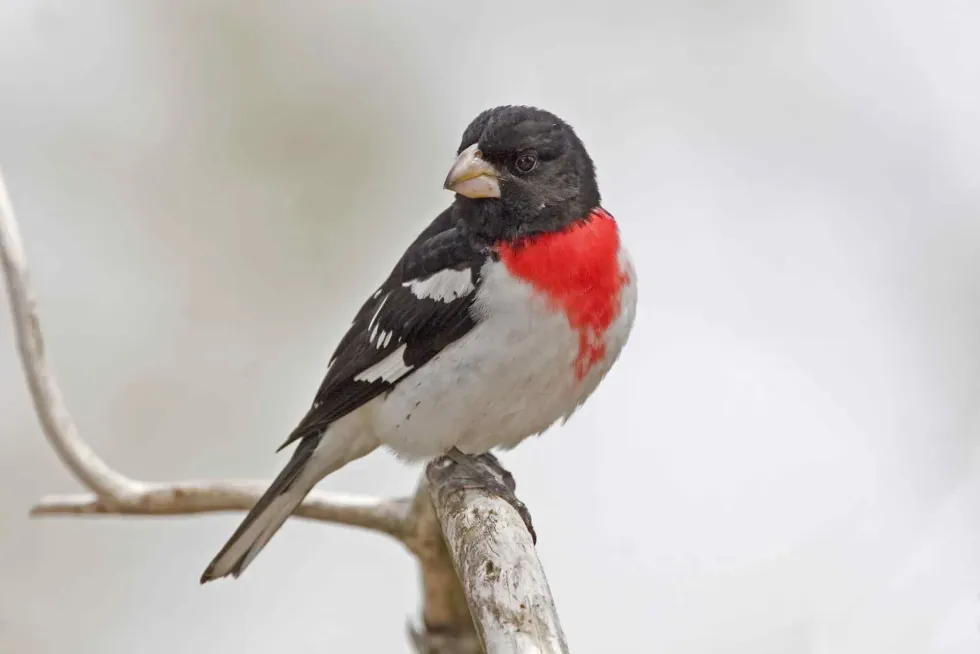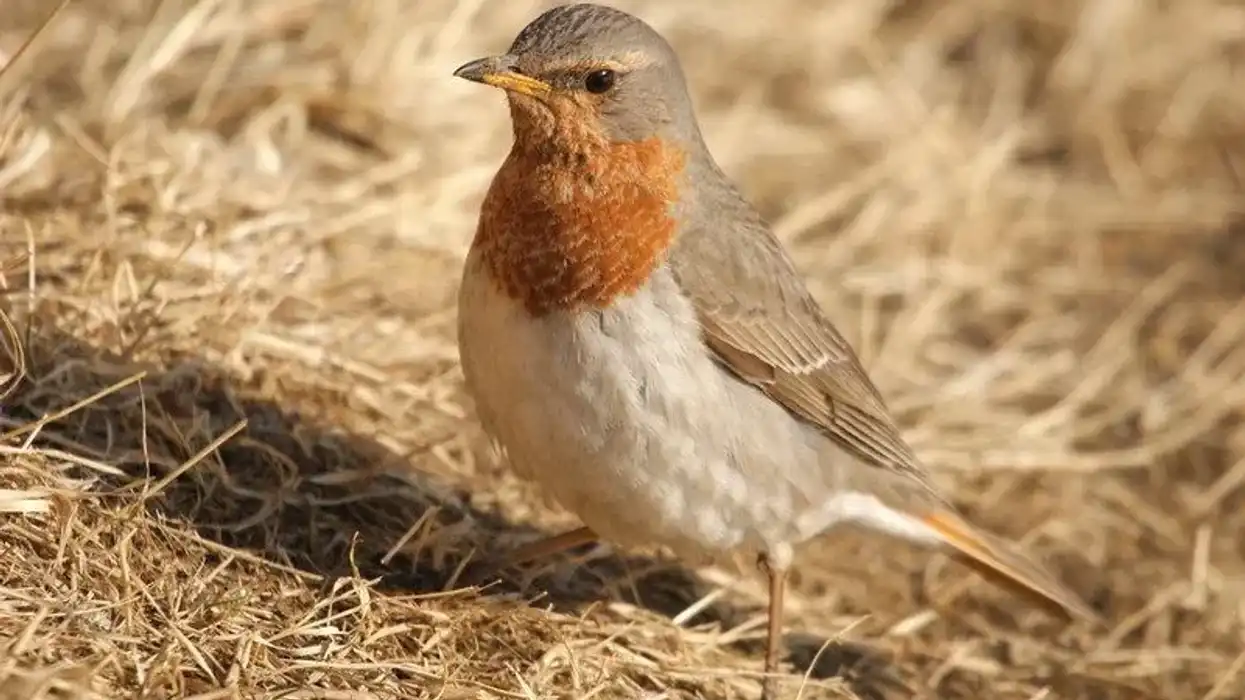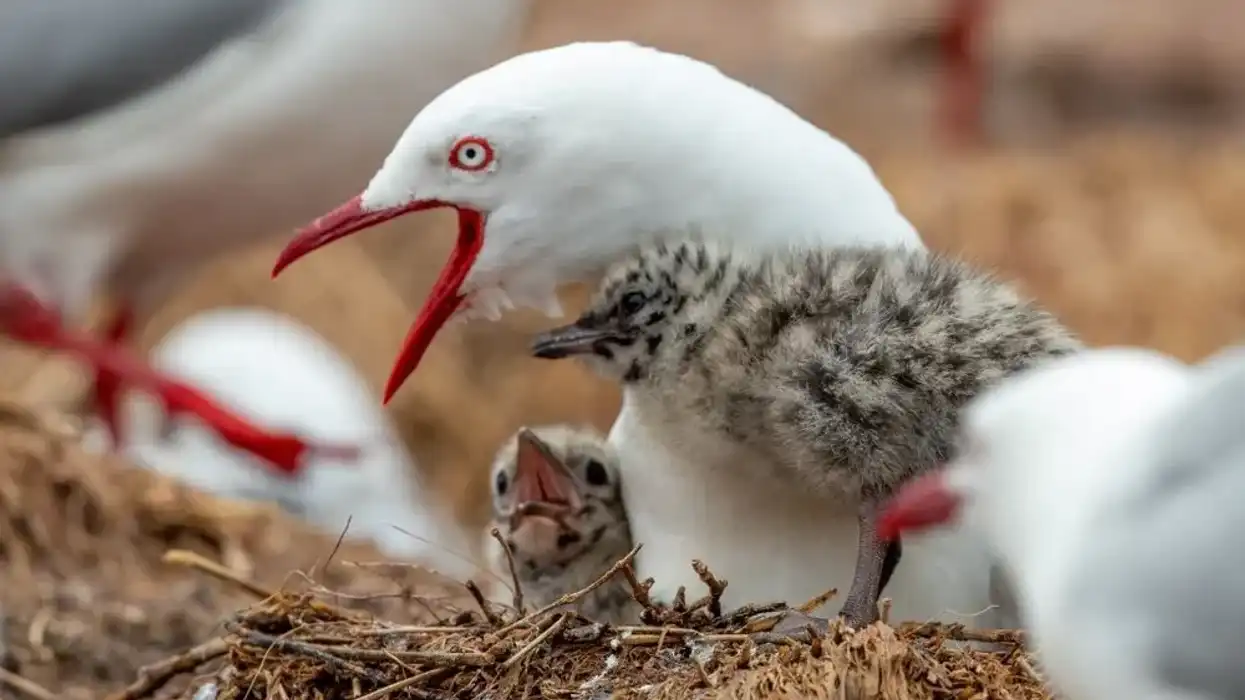Rose-breasted grosbeak (Pheucticus ludovicianus) is renowned for its beautiful and melodious voice and with its Robin-like song sung from the treetops; it is also considered one of the prettiest birds to arrive in late spring. Males and females sing a warm, softly whistled song of several notes that fluctuate alternately.
Rose-breasted grosbeak breeds in moist deciduous and coniferous forests and semi-open ecosystems in the northeast of the United States and central and southeastern Canada.
This bird has a broad triangular-shaped bill and is a stocky, medium-shaped songbird. It has a wide chest, a short body, and a square tail.
Adult males and females have different colored bodies with the male having black and white plumage and rose-colored chevron on its chest and the rose-breasted grosbeak female being relatively dull with brown plumage and white markings all over. Both of them have white spots on their wings and tails.
Their diet also includes a lot of insects, as well as wild seeds and fruits, during the breeding season. During the fall migration, they eat mainly fruit, while in the winter, they eat a variety of invertebrates and plant material.
These are migratory birds and the migration happens at night late in the spring and early in the fall. During the spring and fall seasons, strays can be seen all over the West.
These birds usually live up to 13 years in the wild, but in captivity, they have been known to live up to 24 years.
Read on to know more interesting facts about this gorgeous songbird.
Rose-Breasted Grosbeak Interesting Facts
What type of animal is a Rose-Breasted Grosbeak?
The rose-breasted grosbeak is a type of bird that has a beautiful and melodious voice and is thought to be one of the most beautiful looking birds by bird watchers.
What class of animal does a Rose-Breasted Grosbeak belong to?
These belong to the class of Aves.
How many Rose-Breasted Grosbeaks are there in the world?
Since it has a huge population size and range, it is difficult to know the number of grosbeak (rose-breasted) present in the world but according to the IUCN (International Union for Conservation of Nature ) Red List, the population is quite stable.
Where does a Rose-Breasted Grosbeak live?
Rose-breasted grosbeaks can be found in a variety of heavily forested environments across their breeding range, including swamps, marshes, and pastures.
What is a Rose-Breasted Grosbeak's habitat?
Rose-breasted grosbeaks can be seen breeding across northern parts of North America, from Canadian coastal regions in the east to British Columbia in the west, and in the south in New Jersey, across South Carolina, and west to east of Kansas, the Dakotas, and Nebraska.
Rose-breasted grosbeaks can be found in a wide range of wooded environments, including marsh or damp woods, forests around rivers and streams, and woodland edges.
They prefer open-structured mixed or deciduous woodlands and tend to avoid grasslands and dry woodlands. During their migration, these animals rest in a variety of environments, including shrubs, shrubby sand ridges, coniferous forests, urban centers, and wetlands, to name a few.
They thrive during the winters in Central and South America's forests and semi-open habitats, usually in the middle and upper elevations (up to about 11,000 feet in Colombia).
Who do Rose-Breasted Grosbeaks live with?
These North American birds are usually solitary apart from the breeding season. They usually migrate alone or in a small flock.
How long does a Rose-Breasted Grosbeak live?
These species in the wild survive up to 13 years. The ones in captivity have been known to survive for up to 24 years.
How do they reproduce?
These species are monogamous in nature.
Rose-breasted grosbeaks breed by pairing up during the breeding season.
When females hear the territorial and singing calls of the males on the breeding grounds in the spring, the pairing develops. Males court the female species in a variety of ways, including the swift warble flight and fluff of wings, all of which are followed by a soft tune.
The wing-fluff features the adult male sticking his wings out to the side with his tail extended and flipping his head and body from left to right while he jumps on a branch, whilst the warble flight involves the male flying slowly with his tail stretched and slight movements of the wings.
In May, both the male and female start building the nest 5 to 20 inches above the ground on deciduous trees or huge shrubs with twigs, rootlets, fine grasses, and weeds.
The nest is cup-shaped and is sometimes so thin that the eggs can be seen through it. Despite the thin structure, the nest is strong because it is constructed with twisted roots and twigs and therefore the eggs are secured.
One to five, bluish-green eggs patched with darker shades are laid by the female but both the parents help to incubate the eggs in the nest, and these eggs hatch after two weeks.
The young birds remain with their parents and are nurtured all through the summer before they leave the nest and get ready for migration.
What is their conservation status?
Rose-breasted grosbeaks are not rare even though there has been a minor fall in population in some locations. During migration, these North American birds can be killed by impacts on buildings and structures.
Because of their high population numbers and wide range, the IUCN (International Union of Conservation of Nature) classifies them as Least Concern. These species are typically trapped for trade as cage birds because they look and sound attractive, and this has an uncertain effect on their population.
Rose-Breasted Grosbeak Fun Facts
What do Rose Breasted Grosbeaks look like?

Male and female rose-breasted grosbeaks have distinct color patterns. Rose-breasted grosbeaks range in size from 7.1-8.3 in (18-21 cm) in length and weigh between 1.4-1.7 oz (39-49 gms).
The male rose-breasted grosbeak has a black-colored head, a whitish bill, belly and breast, a black and white dorsal pattern, and a red-colored throat. The female species are relatively dull with brown stripes on the abdomen, breast, and throat and brown and white marks all over the body.
The male rose-breasted grosbeak has black wings with a pink-red flash underneath them, while the female has brown wings with a yellow flash.
The female rose-breasted grosbeak and the black-headed grosbeak have a similar appearance. Sometimes the black-headed grosbeak interbreeds with the rose-breasted grosbeak when their range intertwines in Southern Canada and the central areas of the United States.
How cute are they?
Rose-breasted grosbeaks are very cute because the male rose-breasted grosbeak has a red-colored triangle shape on its breast which looks very beautiful. Also, they have a lovely and mesmerizing voice that attracts the female species during the breeding season.
How do they communicate?
These birds communicate through singing. They have a beautiful and soulful voice and the males sing to establish breeding territories and to attract females. A sharp call and a variety of squawks are often used in different situations. Young females make their first sounds six days after hatching, and young males make their first songs after about 30 days.
How big is a Rose-Breasted Grosbeak?
Rose-breasted grosbeaks range in size from 7.1-8.3 in (18-21 cm) in length which is half the size of Barn owls who range between 12-15 in (32-40 cm).
How fast can a Rose-Breasted Grosbeak fly?
It is not determined how fast these birds can fly. However, a majority of them can cover large distances in one night. When the male species fly, they usually display the salmon pink undertone under their wings.
How much does a Rose-Breasted Grosbeak weigh?
This bird approximately weighs 1.4-1.7 oz (39-49 gm).
What are their male and female names of the species?
Even though they have distinctly different features, the female and the male species do not have a particular name.
What would you call a baby Rose-Breasted Grosbeak?
There is no specific name for a baby rose-breasted grosbeak (pheucticus ludovicianus).
What do they eat?
Seeds, berries, tree seeds, flower buds, and insects are eaten by rose-breasted grosbeaks in different quantities depending on the season. They eat mainly fruits when migrating. Insects, such as beetles, grasshoppers, bugs, as well as snails, and spiders may represent the majority of the yearly diet. The diet of the babies usually consists of insects.
Are they dangerous?
No, rose-breasted grosbeaks are not dangerous but they can be aggressive if someone threatens their territory.
Would they make a good pet?
It is very rare to keep them as pets but they will visit bird feeders if they get sunflower seeds as well as raw peanuts.
Did you know...
Throughout the breeding season, pairs scare away other birds. Often farmers profit from this bird because it eats potato beetles and weeds.
How do you attract rose-breasted grosbeak?
If you want to lure these birds to your backyard, then you can keep a platform-style seed feeder filled with their most favorite sunflower seeds and raw peanuts.
What does a rose-breasted grosbeak sound like?
Rose-breasted grosbeaks tend to give penetrating and sharp calls and continuous squeaks when they are alarmed.
Here at Kidadl, we have carefully created lots of interesting family-friendly animal facts for everyone to discover! Learn more about some other birds including the secretary bird and the blue and yellow macaw.
You can even occupy yourself at home by drawing one of our Rose breasted grosbeak coloring pages.










